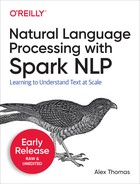Book Description
If you want to build an enterprise-quality application that uses natural language text, but aren’t sure where to begin or what tools to use, this practical guide will help get you started. You’ll explore special concerns for developing text-based applications, such as performance.
Alex Thomas, data scientist at Indeed, shows software engineers and data scientists how to build scalable NLP applications using deep learning and the Apache Spark NLP library. Through concrete examples, practical and theoretical explanations, and hands-on exercises for using NLP on the Spark processing framework, this book teaches you everything from NLP basics to applications of powerful modern techniques.
- Process text in a distributed environment using Spark NLP, a production-ready library for NLP built on Spark
- Create, tune, and deploy your own word embeddings
- Adapt your NLP applications to multiple languages
- Use text in machine learning and deep learning
- Learn why these techniques work from a machine learning, linguistic, and practical point of view
